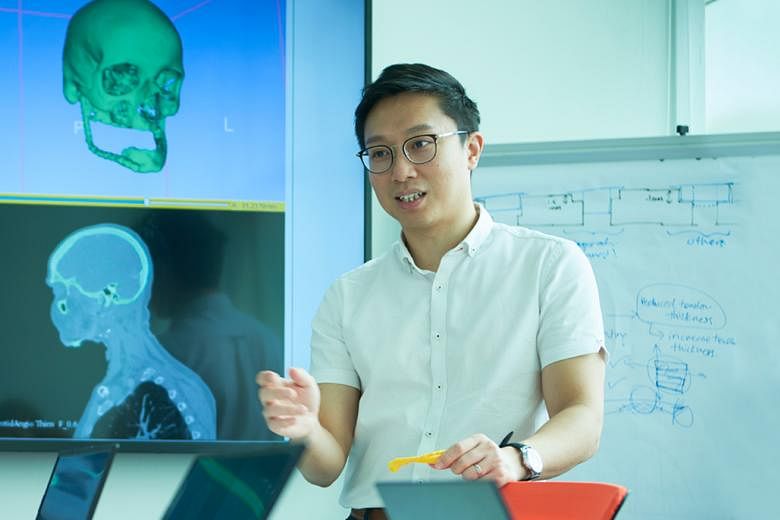Even with just 33 employees, homegrown medical devices business Osteopore International is putting Singapore on the world map. Situated in JTC's MedTech Hub, the firm produces 3D-printed biomimetic implants that gradually disintegrate into carbon dioxide and water while helping damaged bones to regrow, averting the potential side effects of having permanent implants in the body. Since its establishment in 2003, it has already sold about 50,000 of its implants worldwide.
"That's quite an achievement for us. We are also very proud of this milestone as a Singapore company," says Osteopore chief technology officer (CTO) Dr Lim Jing, 36.
Dr Lim Jing and other SME leaders share their opinions on embracing Industry 4.0 technologies.
The firm's success story has been partly due to its innovative product, which gives patients a better quality of life and reducing overall healthcare cost. Equally important has been its determination to embrace new and useful technologies, upskill its staff and make the most of its resources. By harnessing 3D printing technology, it has been able to customise implants for different surgical procedures such as complex skull reconstructions after traumatic injuries.

"As our business grows and our implants get to more patients, we are also always thinking about one thing: how we should be developing our production and transforming it to make it more efficient," Dr Lim adds.
Putting people first
Last year, at its landlord JTC's recommendation, Osteopore signed up for a 20-week programme designed by consultancy McKinsey & Company to help medical technology firms increase productivity. The programme was introduced to Osteopore under JTC's Industry Connect initiative, which connects companies located in JTC estates to partners and programmes for technology adoption, collaboration, upskilling and other opportunities.
Dr Lim says that the programme lit a fire in his firm: "We came up with a blueprint that maps out how we can achieve a digitalisation transformation over the next couple of years." It also reinforced the need to take care of staff during such transitions. He explains: "That's the most important thing. You have to make sure that they are on board with you, they play a significant role during and after the transformation and that you keep them motivated throughout the process."
Quality assurance technician Cathleen Kung, 23, shares how Osteopore followed through on its learnings from the programme. She recalls: "One of the activities we did was value stream mapping, to find out where our bottlenecks were. When it came to the quality control process, we realised that I was the only person doing the final checks."

The firm revamped the process and roped in operators to perform the checks. This improved the overall quality of its products and freed up Ms Kung to take on greater responsibilities. "Apart from maintaining our quality control system, I now train other people to follow our processes," she says. "This has been very satisfying."
Over the years, Osteopore has also thrived by casting its net wide for employees. The ages of its staff range from 19 to 69. "What you get with mature folks is a sense of emotional stability and maturity that helps to stabilise the work environment," explains Dr Lim. "When you have people of different ages interacting, it also helps with communication and conflict resolution."
Three years ago, Madam Alice Lim joined Osteopore as a 3D-printing operator after more than three decades in the travel industry. The then- 59-year-old was attracted by the role's flexible hours. She credits supportive colleagues and superiors at Osteopore for her smooth transition into a new career.
She says, "I didn't have any background in 3D printers, but they were very open to teaching me the necessary skills. Since I came on board, the team I work in has more than doubled in size, and we have more machines and more products, but we have maintained the same welcoming culture."

She adds that her experience underscores the possibilities open to those who are willing to learn: "Be open and adaptable to new environments. Never stop learning new things, and when you are in doubt about anything, ask. If you don't ask, you will never learn."
Innovating with Industry 4.0
Looking ahead, Osteopore is exploring how it can tap on Industry 4.0 technologies to further enhance its productivity and accelerate its growth. Dr Lim explains: "To continue to supply globally, from Singapore, we need to get to a very efficient level of production. Thus the need for us to move to Industry 4.0, so we can remain competitive in the medical device industry.
"The simple solution to maximise output would be to buy more machines or rent more units, and get the entire production floor filled up. But the more exciting idea is to expand vertically instead of horizontally. Can we get more products produced at the same time with the same effort? That's where ideas about machines, robots and data transmission fall into place."
Last year, during the Covid-19 pandemic, the company adopted simple digital tools and reaped benefits. Dr Lim shares: "When we were allowed only about 50 per cent of our production staff on the floor due to Covid-19 safety measures, we were challenged every day to think about how we were going to track activities, and make sure there were no handover or takeover issues.
"We implemented a couple of digital tools that we had never used previously - we made use of live online spreadsheets, and programmed them so that activities could be controlled from a software standpoint to weed out human error."
It is now working with the Agency for Science, Technology and Research to implement the use of robotic technology to automate key parts of its manufacturing operations. This would enable it to achieve continuous manufacturing, which is crucial to its expansion ambitions.
Dr Lim explains: "We want to see if we can run production around the clock, and this is an area where robots can shine. In the near term, our most immediate need is to grow our revenue," he says. "At the same time, we must prepare our production flow, by making our current processes smoother and finding new ways of working."
Flying the flag for Singapore
As Osteopore deploys more Industry 4.0 technologies, it will continue to invest in its staff's professional development. "At the end of the day, as much as we focus on technology, advancements and robots, the source of creation will still be human. So, we have to respect that. If we understand the value of both, we can really maximise what we have at our disposal," says Dr Lim.

He urges other firms in Singapore's manufacturing sector - which makes up 21 per cent of the country's gross domestic product - to get the ball rolling on their own Industry 4.0 initiatives.
"You don't have to take a quantum leap. You can take small, incremental steps and progress along the way. It comes down to the needs of your organisation," he advises.
Firms will also have a higher chance of success if they bring relevant staff into the digitalisation process early, seek their feedback and ideas regularly, and act on them.
"When we implement ideas, we ask our employees for feedback on whether it works or not, and we are happy to make adjustments. It's an ongoing conversation. After all, technology is to supplement people and make us more efficient," he says.
He believes that Osteopore will flourish and fly the flag even higher for Singapore as it forges ahead on its Industry 4.0 journey. "It's always companies from the US or Europe leading in the medical device space, particularly in high-risk devices," he says. "We want to show that Osteopore can be a champion for Singapore, and show the world that Singapore is serious in manufacturing medical devices."
-
This is the third in a four-part series on how SME innovators are shaping the future of manufacturing. Find out more about JTC Industry Connect here.


